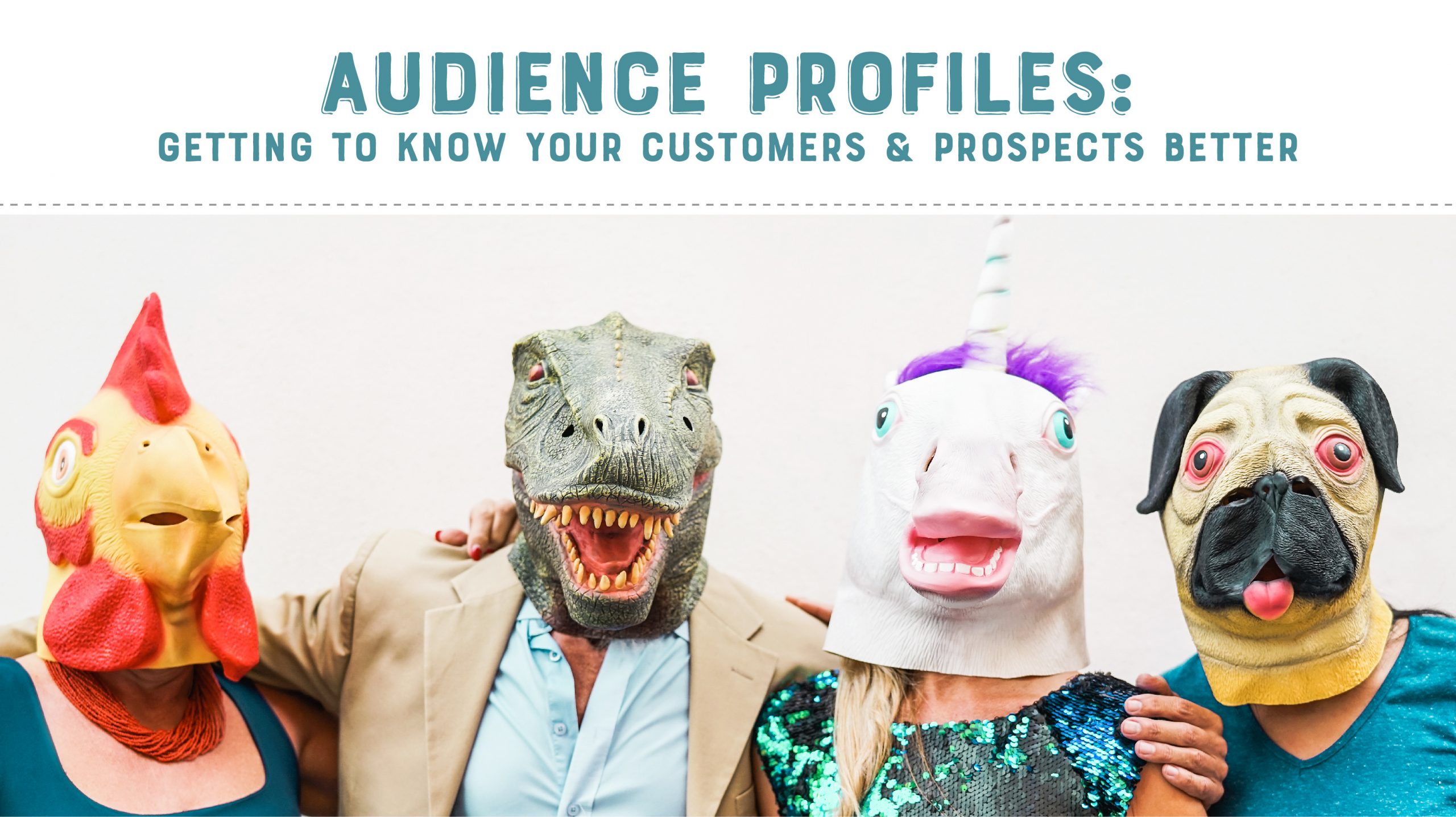Check out our audience profiles worksheet available for download at the end of this post.
A few months ago, we presented a webinar about getting feedback from your customers because people’s perception is shifting in light of the COVID-19 pandemic and a host of other factors. There are many different ways you can use feedback, however, we wanted to share an effective option for documenting this data: Audience Profiles.
What are Audience Profiles?
Audience profiles summarize the demographics and psychographics of the people in your current audience or the audience you are trying to connect with in a quick and easy to share format. Essentially, audience profiles are stereotypes of these people that help you better understand not only who they are, but also where they are coming from and how they think.
Why You Should Care About Audience Profiles
We love how Seth Godin puts it in his blog post titled “Applying Effort.” When you want to send out a message, you could blast it out to each and every person you’ve ever met at once, or you could identify one person to send that message to and spend a lot of time putting the right message in front of their face time and again. But are you really going to get through with either of those routes? Probably not, BUT if you start putting the right tools in your toolbox and better understand who you’re speaking to, you’re more likely going to get your point across.

Now, imagine if everyone in your organization followed the same path? No one is working from their own assumptions and you’re all following the same map and working toward the same goal. With everyone on the same path, you stand an even better chance of truly connecting with your audience members because you’re maximizing your resources to reach both customers and prospects exactly where they are, rather than aiming your message in their general direction and hoping they find it. When you have audience profiles, you are better equipped to do because you’ve intentionally spent time learning not only who you are speaking to, but what pain points they are currently facing and how those pain points affect their decision making process.

What’s Included in an Audience Profile?
Audience profiles consist of a mix of information based on demographics and psychographics to create a quick snapshot of the types of people currently in your audiences to help you understand who they are, how they think, and what makes them tick. They can also give you clues into how audience members consume information, their values, education level, and a host of other factors that all play a role in how they perceive information and make decisions based on their perceptions.
The demographic factors you might want to consider include:

- Age
- Title / Occupation
- Gender
- Zip Code / Location
- Marital Status
- Family Size
- Languages Spoken
- Race/Culture
- Household Income/Social Class

Psychographic data, on the other hand, might include factors like:
- Activities or Hobbies
- Personal and / or Cultural Values
- Behaviors
- Interests
- Lifestyle
- How / Where They Consume Information
Creating Audience Profiles
It might sound like an overwhelming job, but the beauty of creating audience profiles is that you can start small and grow your profiles to be more elaborate over time. It’s kind of like snorkeling to get your feet wet and gaining a basic understanding of your audience, and then scuba diving to really go deeper and start learning not only the habits of your audience, but more about their habitat as well.
Snorkeling for Beginners: Observation + Documentation

If you’re just getting started, focus on just observing your current audience (customers and prospects) and noting what you see.
- Step 1: Gather your team (and perhaps a member of the RPS team) who interact with your customers and prospects and support your marketing and customer service efforts.
- Step 2: List your products or services, and note your costs and revenues to give you context for each item. Then, discuss any patterns you notice about who is buying or using each product or service and determine groupings of similar characteristics.
- Step 3: Fill in one Audience Profile per audience with your observations.
- Step 4: Share your findings with the entire organization.
- Step 5: Schedule a time to come back in 3-6 months to review your profiles to see if your observations were correct and make any necessary revisions.
Advanced Snorkeling: Observation + Documentation + Research
When you’re ready to learn a little bit more, but aren’t ready to do a deep dive, you can add a few more steps to the process starting at Step 3:

- Step 3a: Research using industry and government resources. City/state government and Census data are great resources, as are foundations or groups that conduct research specific to your industry. For example, if your organization is a nonprofit in Georgia, you might want to see what’s available from the Georgia Center for Nonprofits or the United Way.
- Step 3b: Regroup with your team and fill in your audience profiles based on your new research.
Scuba Diving: Data Collection & Market Research

When you’re ready to deep dive into even more information and data collection, it helps to add some market research and audience personas into your process. Market research is a more lengthy process in which you are gathering information about your customers and prospects to build more realistic profiles that help you determine how likely your product or service is to be successful and sustainable among these audiences. This research tells you how these individuals conduct their own research when looking for products or services like yours, helps you spot industry trends, and factors that influence the decision to buy, among others (HubSpot).
With all this information in hand, you’re probably wondering what to do with all that information. The answer is you take your audience profiles to the next level and create audience personas! With audience personas, you’re creating a fictitious character that represents the ideal types of people you want to connect with, send your message to, and ultimately convert them into customers. In short, if it relates to the process of either converting a prospect or retaining a customer, an audience persona can come in handy–everything from developing new products or services to content creation and distribution and the post-sales process can benefit from the creation of audience profiles.



When you’ve hit the Scuba Diving stage, you’re likely going to be hiring a market research group to do the work for you. These groups have access to more in-depth research and studies to help paint a more accurate picture of the people you intend to connect with. They also conduct their own surveys to learn more about consumers and their interests, habits, and needs. The assistance of a market research group can be particularly useful when you want to test a new product or service to see if the audience would really need it. This type of research goes beyond what a marketing agency offers and is a more specialized service. If this an area you are in need of support, we have market research partners we are happy to connect you with.
Now What?
Now that you know a little more about what audience profiles are and how to start creating them for your organization, it’s time to get to work! If you’re not sure where to start, contact us to request a marketing consultation. During this consultation we can take a look at any profiles you’ve already started or help you begin the process of creating audience profiles for your organization. Or you can download our audience profiles worksheet by filling out the form below.
Not quite ready to start your audience profiles yet or looking for more information? Read our previous audience profiles blog for more information.


